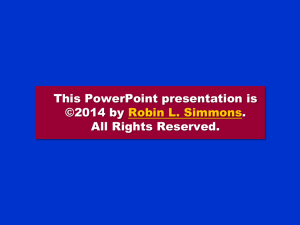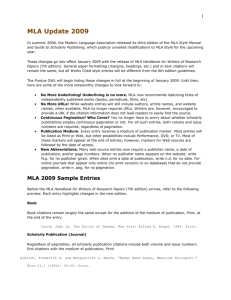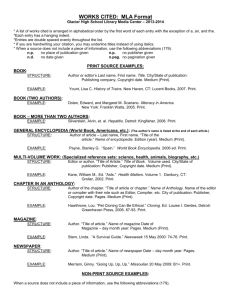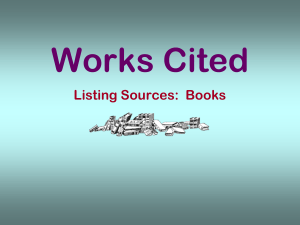MLA Basic Format
advertisement
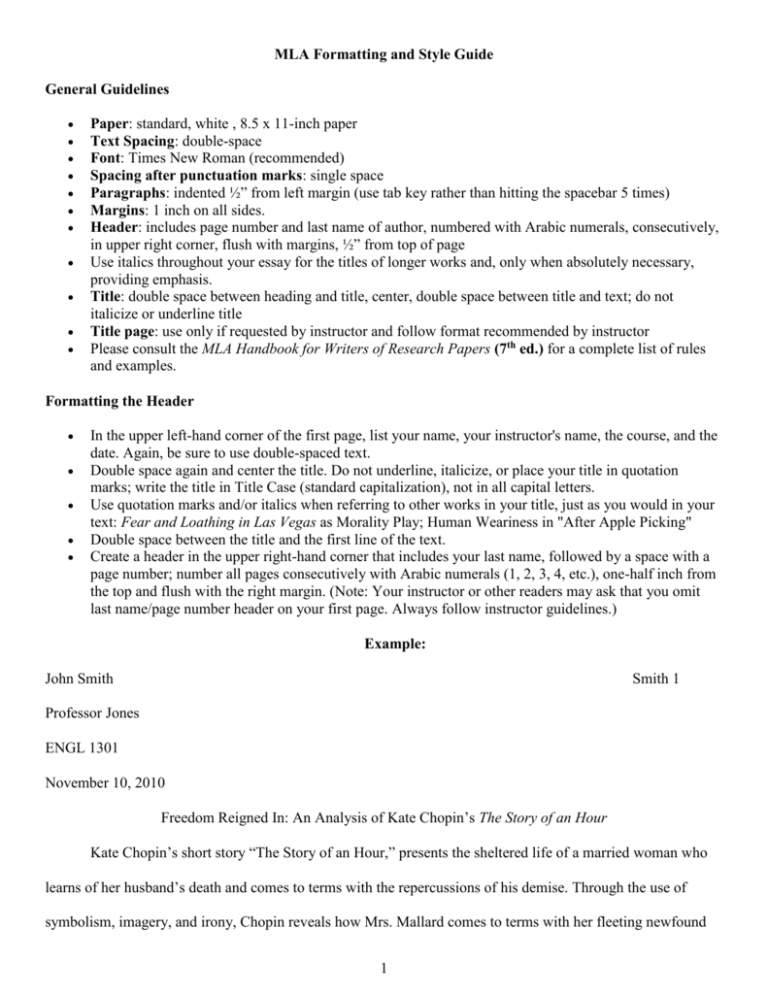
MLA Formatting and Style Guide General Guidelines Paper: standard, white , 8.5 x 11-inch paper Text Spacing: double-space Font: Times New Roman (recommended) Spacing after punctuation marks: single space Paragraphs: indented ½” from left margin (use tab key rather than hitting the spacebar 5 times) Margins: 1 inch on all sides. Header: includes page number and last name of author, numbered with Arabic numerals, consecutively, in upper right corner, flush with margins, ½” from top of page Use italics throughout your essay for the titles of longer works and, only when absolutely necessary, providing emphasis. Title: double space between heading and title, center, double space between title and text; do not italicize or underline title Title page: use only if requested by instructor and follow format recommended by instructor Please consult the MLA Handbook for Writers of Research Papers (7th ed.) for a complete list of rules and examples. Formatting the Header In the upper left-hand corner of the first page, list your name, your instructor's name, the course, and the date. Again, be sure to use double-spaced text. Double space again and center the title. Do not underline, italicize, or place your title in quotation marks; write the title in Title Case (standard capitalization), not in all capital letters. Use quotation marks and/or italics when referring to other works in your title, just as you would in your text: Fear and Loathing in Las Vegas as Morality Play; Human Weariness in "After Apple Picking" Double space between the title and the first line of the text. Create a header in the upper right-hand corner that includes your last name, followed by a space with a page number; number all pages consecutively with Arabic numerals (1, 2, 3, 4, etc.), one-half inch from the top and flush with the right margin. (Note: Your instructor or other readers may ask that you omit last name/page number header on your first page. Always follow instructor guidelines.) Example: John Smith Smith 1 Professor Jones ENGL 1301 November 10, 2010 Freedom Reigned In: An Analysis of Kate Chopin’s The Story of an Hour Kate Chopin’s short story “The Story of an Hour,” presents the sheltered life of a married woman who learns of her husband’s death and comes to terms with the repercussions of his demise. Through the use of symbolism, imagery, and irony, Chopin reveals how Mrs. Mallard comes to terms with her fleeting newfound 1 In-Text Citation Parenthetical Citation: source information is dependent upon reference format and information included in the complete reference on the words cited page. Author-Page Style: For cited works with a known author; in parenthesis () include author’s last name and page numbers from which the idea (paraphrase or quote) was excerpted OR include the author’s name within the text and place the pagination in parenthesis at the end of the sentence with the final punctuation. Abridged Title-Page Style: For cited works without a known author, include in parentheses an abridged title and pagination. Example of In-Text Citation As a woman oppressed, Mrs. Mallard could possibly represent a caged bird, regarded as a possession by its owner. Gazing “away off yonder on one of those patches of blue sky,” Mrs. Mallard is representative of a creature that was “quite motionless,” too lethargic and brought down to fly as freely as it should (Chopin 23). Chopin uses Mrs. Mallard’s name as both an image and a symbol, contributing to the theme of oppression (21). Works Cited Page Guidelines: Format: separate page at end of essay or research paper, 1” margins, pagination should be a continuation of paper’s pagination, header should be formatted the same as paper’s header Title: center Works Cited, 1” from top of page Spacing: double space all entries; do not add spaces between entries Indentation: hanging Medium of Publication: for each work cited include medium of publication (usually Print or Web, but can include DVD, Interview, CD-ROM, etc.) Items published in print and electronic formats: if a cited source was originally issued in print form but was retrieved from an online source, include the name of the online database in italics Short and long titles: in general, use italics for titles of large works (books, journals, plays, epic poems) and quotation marks for the titles of shorter works (essays, articles, poems) Listing Author Names: Entries are listed alphabetically by the author's last name (or, for entire edited collections, editor names). Author names are written last name first; middle names or middle initials follow the first name: Burke, Kenneth Levy, David M. Wallace, David Foster More than One Work by an Author: If you have cited more than one work by a particular author, order the entries alphabetically by title, and use three hyphens in place of the author's name for every entry after the first: Burke, Kenneth. A Grammar of Motives. [...] ---. A Rhetoric of Motives. [...] Work with No Known Author: Alphabetize works with no known author by their title; use a shortened version of the title in the parenthetical citations in your paper. In this case, Boring Postcards USA has no known author. 2 MLA Format Works Cited Examples: Works Cited from Print Sources Book: Lastname, Firstname. Title of Book. Place of Publication: Publisher, Year of Publication. Medium of Publication. Proulx, Annie. Close Range. New York: Scribner, 1999. Print. With two authors: Murray, William D. and Francis J. Rigney. Paper Folding for Beginners. New York: Dover, 1960. Print. Reference Book: Portuguese-English Dictionary: Dicionario Ingles-Portugues. Lausanne: Berlitz, 1983. Print. Individual work from an anthology: Lastname, Firstname. “Title of Essay.” Title of Collection. Ed. Editor’s Name(s). Place of Publication: Publisher, Year. Pagination. Medium of Publication. Martin, Dale B. “Paul Without Passion: On Paul’s Rejection of Desire in Sex and Marriage.” The Writings of St. Paul. 2nd ed. Ed. Wayne A. Meeks and John T. Fitzgerald. New York: Norton, 2007: 678-94. Print. Journal article: Author(s). “Title of Article.” Title of Journal Volume.Issue (Year): pagination. Medium of Publication. Morgan, B.J. “Exercise: Alternative Therapy for Heart Failure-Associated Sleep Apnea?” Sleep 32.5 (2009): 585-6. Print. Magazine article: Author(s). “Title of Article.” Title of Periodical Day Month Year: pagination. Medium of publication. Zakaria, Fareed. “There’s More to Fear Than Fear.” Newsweek 2 Feb. 2009: 26-28. Print. Works cited from electronic sources Website (use n.p. if publisher name is unavailable, n.d. if publishing date is unknown and n. pag. if unpaginated): Editor, author, compiler name. “Title of Article within the Website.” Name of Site. Name of site publisher or sponsor, date of resource creation. Medium of Publication. Date of access. 3 Castro, Fidel. “Key Address.” World Conference Against Racism, Racial Discrimination, Xenophobia and Related Intolerance. United Nations, 1 Sep. 2001. Web. 12 Mar. 2009. Article in an Online-only Scholarly Journal: Author(s). “Title of Article.” Title of Journal Volume.Issue (Year): pagination. Medium of Publication. Date of access. Dolby, Nadine. “Research in Youth Culture and Policy: Current Conditions and Future Directions.” Social Work and Society: The International Online-Only Journal 6.2 (2008): n. pag. Web. 20 May 2009. An Article from an Online Database (or Other Electronic Subscription Service): Author(s). “Title of Article.” Title of Journal Volume.Issue (Year): pagination. Name of Database. Medium of Publication. Date of access. Junge, Wolfgang, and Nathan Nelson. “Nature's Rotary Electromotors.” Science 29 Apr. 2005: 642-44. Science Online. Web. 5 Mar. 2009. Online Image (photograph or artwork) (use n.d. if date is unknown): Creator’s name. Title of Image. Date. Location of image. Title of Website. Medium of Publication. Date of access. Chagnell, Marc. White Crucifixion. 1938. Art Institute of Chicago. The Collection: Featured Works. Web. 10 June 2009. Some of the information in this formatting and style guide was retrieved from the Purdue Online Writing Lab (OWL) 4
